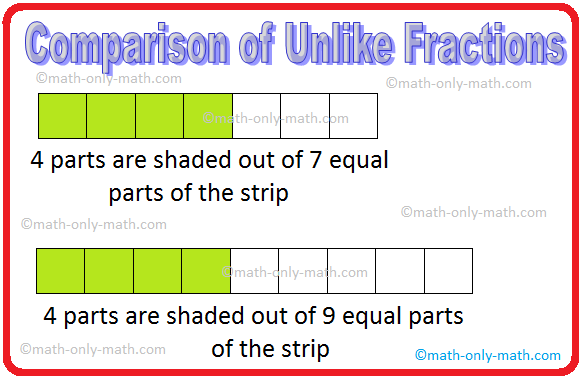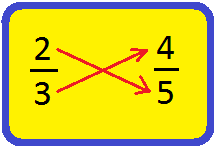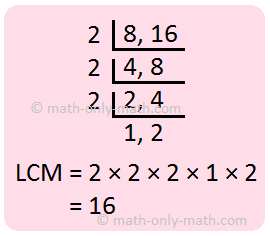Subscribe to our ▶️ YouTube channel 🔴 for the latest videos, updates, and tips.
Comparison of Unlike Fractions
In comparison of unlike fractions, we change the unlike fractions to like fractions and then compare.
Let us compare two fractions \(\frac{4}{7}\) and \(\frac{4}{9}\) which have same numerator.
Since 4 shaded parts of 7 is bigger than the 4 shaded parts of 9 therefore \(\frac{4}{7}\) > \(\frac{4}{9}\).
To compare two fractions with different numerators and different denominators, we multiply by a number to convert them to like fractions.
Let us consider some of the examples on comparing fractions
(i.e. unlike fractions).
1. Which one is greater, \(\frac{4}{7}\) or \(\frac{3}{5}\)?
First we convert these fractions into like fractions. To convert unlike fraction into like fraction first of all find the L.C.M. of their denominators.
L.C.M. of 7 and 5 = 35
Now, divide this L.C.M. by the denominator of both the fractions.
35 ÷ 7 = 5
35 ÷ 5 = 7
Multiply both the numerator and denominator with the number you get after dividing.
i.e., \(\frac{4 × 5}{7 × 5}\) = \(\frac{20}{35}\)
\(\frac{3 × 7}{5 × 7}\) = \(\frac{21}{35}\)
because \(\frac{21}{35}\) > \(\frac{20}{35}\)
So, \(\frac{3}{5}\) > \(\frac{4}{7}\)
We can compare two fractions by cross multiplication also.
Let us solve the above example by cross multiplication. Here, we cross multiply as follows.
4 × 5 = 20
3 × 7 = 21
Since, 21 > 20
Therefore, \(\frac{3}{5}\) > \(\frac{4}{7}\)
2. Compare 3\(\frac{2}{5}\) and 2\(\frac{3}{4}\).
First we convert these mixed numbers into improper fractions.
2\(\frac{3}{4}\) = \(\frac{4 × 2 + 3}{4}\) = \(\frac{11}{4}\)
3\(\frac{2}{5}\) = \(\frac{5 × 3 + 2}{5}\) = \(\frac{17}{5}\)
Now, we compare \(\frac{11}{4}\) and \(\frac{17}{5}\) by cross multiplication.
11 × 5 = 55 and 17 × 4 = 68
We see that 68 > 55.
Therefore, \(\frac{17}{5}\) > \(\frac{11}{4}\) or, 3\(\frac{2}{5}\) > 2\(\frac{3}{4}\)
3. Let us compare \(\frac{5}{7}\) and \(\frac{3}{5}\).
\(\frac{5}{7}\) = \(\frac{5 × 5}{7 × 5}\) = \(\frac{25}{35}\)
Multiply the numerator and denominator by 5.
\(\frac{3}{5}\) = \(\frac{3 × 7}{5 × 7}\) = \(\frac{21}{35}\)
Multiply the numerator and denominator by 7.
Hence, \(\frac{25}{35}\) > \(\frac{21}{35}\)
Therefore, \(\frac{5}{7}\) > \(\frac{3}{5}\)
We will learn an alternative method i.e. cross multiply to compare the given fractions.
4. Let us compare \(\frac{2}{3}\) and \(\frac{4}{5}\).
2 × 5 = 10 and 3 × 4 = 12
Since, 12 > 10, hence \(\frac{4}{5}\) > \(\frac{2}{3}\)
Comparison of Fraction with Different Numerators and Denominators:
1. Compare \(\frac{3}{4}\) and \(\frac{5}{11}\)
Step I: Find the least common denominator by finding the L.C.M. of the denominators 4 and 11.
L.C.M. of 4 and 11 = 4 × 11 = 44
Step II: Change the given fractions into equivalent fractions with denominator 44.
\(\frac{3 × 11}{4 × 11}\) = \(\frac{33}{44}\); \(\frac{5 × 4}{11 × 4}\) = \(\frac{20}{44}\);
\(\frac{3}{4}\) = \(\frac{33}{44}\) \(\frac{5}{11}\) = \(\frac{20}{44}\)
\(\frac{33}{44}\) > \(\frac{20}{44}\)
Therefore, \(\frac{3}{4}\) > \(\frac{5}{11}\)
2. Compare \(\frac{6}{8}\) and \(\frac{14}{16}\)
|
L.C.M. of 8 and 16 is 16. \(\frac{6 × 2}{8 × 2}\) = \(\frac{12}{16}\); \(\frac{6}{8}\) = \(\frac{12}{16}\) \(\frac{14 × 1}{16 × 1}\) = \(\frac{14}{16}\) \(\frac{12}{16}\) < \(\frac{14}{16}\) Therefore, \(\frac{6}{8}\) < \(\frac{14}{16}\) |
3. Compare \(\frac{6}{8}\) and \(\frac{14}{16}\) by using the method of cross multiplication.
\(\frac{3}{16}\) < \(\frac{2}{4}\) because 12 < 32
4. Compare 6\(\frac{1}{4}\) and \(\frac{12}{2}\)
Change 6\(\frac{1}{4}\) to an improper fraction.
6\(\frac{1}{4}\) = \(\frac{(6 × 4) + 1}{4}\) = \(\frac{25}{4}\)
\(\frac{25}{4}\) > \(\frac{12}{2}\) because 50 > 48
Comparison of Fractions with Unlike Numerators and Unlike Denominators
To compare two fractions having unlike numerators and unlike denominators, we first convert them into the fractions having like (same) denominator. This can be done by multiplying the numerator and the denominator of each fraction by a suitable number. Then we compare the fractions as usual.
5. Consider \(\frac{1}{5}\) and \(\frac{3}{4}\)
Solution:
\(\frac{1}{5}\) = \(\frac{1 × 4}{5 × 4}\) [Multiplying the numerator and the denominator by 4]
= \(\frac{4}{20}\)
\(\frac{3}{4}\) = \(\frac{3 × 5}{4 × 5}\) [Multiplying the numerator and the denominator by 5]
= \(\frac{15}{20}\)
Clearly, \(\frac{4}{20}\) < \(\frac{15}{20}\), (Since 4 < 15 )
Hence, \(\frac{1}{5}\) < \(\frac{3}{4}\)
Another method:
Two fractions can be compared by using the method of cross multiplication.
6. Consider \(\frac{2}{11}\) and \(\frac{4}{7}\)
Solution:
Given fractions are \(\frac{2}{11}\) and \(\frac{4}{7}\)
Now 2 × 7 = 14 and 4 × 11 = 44
Since angle 4 > 14, hence \(\frac{2}{11}\) < \(\frac{4}{7}\)
7. Consider \(\frac{4}{15}\) and \(\frac{2}{13}\)
Solution:
Given fractions are \(\frac{4}{15}\) and \(\frac{2}{13}\)
Now 4 × 13 = 52 and 15 × 2 = 30
Since 52 > 30, hence \(\frac{4}{15}\) > \(\frac{2}{13}\)
Worksheet on Comparison of Unlike Fractions
1. Put the appropriate sign >, < or = in the box.
(i) \(\frac{4}{25}\) _____ \(\frac{16}{100}\)
(ii) \(\frac{1}{8}\) _____ \(\frac{3}{32}\)
Answer:
1. (i) =
(ii) >
2. Fill in each blank by putting > or < in each of the following to make the statement true:
(i) \(\frac{3}{20}\) _____ \(\frac{7}{20}\)
(ii) \(\frac{5}{8}\) _____ \(\frac{5}{16}\)
(iii) \(\frac{15}{19}\) _____ \(\frac{12}{19}\)
(iv) \(\frac{14}{15}\) _____ \(\frac{14}{17}\)
(v) \(\frac{5}{11}\) _____ \(\frac{7}{11}\)
(vi) \(\frac{10}{21}\) _____ \(\frac{10}{13}\)
Answer:
2. (i) <
(ii) >
(iii) >
(iv) >
(v) <
(vi) <
3. Which is the smaller in each of the following pairs of fractions?
(i) \(\frac{7}{15}\), \(\frac{1}{5}\)
(ii) \(\frac{1}{9}\), \(\frac{4}{21}\)
(iii) \(\frac{18}{25}\), \(\frac{2}{5}\)
(iv) \(\frac{5}{12}\), \(\frac{3}{10}\)
(v) \(\frac{9}{20}\), \(\frac{7}{15}\)
(vi) \(\frac{8}{21}\), \(\frac{7}{20}\)
Answer:
3. (i) \(\frac{1}{5}\)
(ii) \(\frac{4}{21}\)
(iii) \(\frac{18}{25}\)
(iv) \(\frac{5}{12}\)
(v) \(\frac{9}{20}\)
(vi) \(\frac{8}{21}\)
4. Compare each pair of fractions and write < or < in the box:
(i) \(\frac{5}{7}\) □ \(\frac{5}{9}\)
(ii) \(\frac{6}{11}\) □ \(\frac{7}{14}\)
(iii) \(\frac{1}{7}\) □ \(\frac{1}{8}\)
(iv) \(\frac{4}{11}\) □ \(\frac{4}{7}\)
(v) \(\frac{6}{7}\) □ \(\frac{6}{11}\)
(vi) \(\frac{3}{7}\) □ \(\frac{3}{5}\)
Answer:
4. (i) >
(ii) >
(iii) >
(iv) <
(v) >
(vi) <
Related Concept
● Representation of a Fraction
● Properties of Equivalent Fractions
● Comparison of Like Fractions
● Comparison of Fractions having the same Numerator
● Conversion of Fractions into Fractions having Same Denominator
● Conversion of a Fraction into its Smallest and Simplest Form
● Addition of Fractions having the Same Denominator
● Subtraction of Fractions having the Same Denominator
● Addition and Subtraction of Fractions on the Fraction Number Line
4th Grade Math Activities
From Comparison of Unlike Fractions to HOME PAGE
Didn't find what you were looking for? Or want to know more information about Math Only Math. Use this Google Search to find what you need.







![To convert a percentage into a fraction, place the given number over 100 and reduce it to its lowest term. Consider the following example: (i) 20% [We know % = 1/100]](/image-thumbnails/convert-a-percentage-into-a-fraction.png/default.webp)














New! Comments
Have your say about what you just read! Leave me a comment in the box below. Ask a Question or Answer a Question.